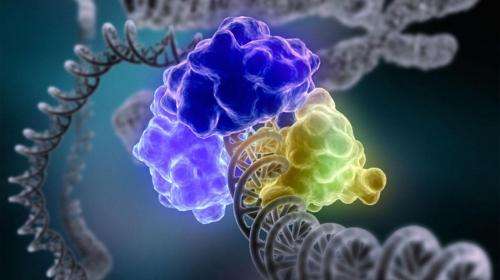Researchers clarify how DNA damage signaling works

The DNA molecule is chemically unstable, giving rise to DNA lesions of various kinds. That is why DNA damage detection, signaling and repair, collectively known as the DNA damage response, are needed. The DNA damage response is immensely important, for example, for ensuring the highest possible quality of DNA before replication prior to cell division. If the damaged DNA is replicated, the risk of cancer and other diseases increases significantly due to mutations. All in all this may lead to the death of a cell itself.
DNA repair is performed by enzymes that find the damaged sections and repair them before replication. These enzymes have different functions. Some of them recognize the damaged bases and signal the other enzymes, which repair the DNA.
Ataxia-telangiectasia mutated (ATM) is a kinase that transmits the signal from damaged DNA to cellular repair systems. Scientists used to think that ATM exclusively recognizes DNA double-strand breaks (DSBs). These breaks are extremely dangerous because they may lead to loss of genetic information.
Svetlana V. Khoronenkova, a postdoctoral researcher at Lomonosov Moscow State University and at the University of Oxford was among the scientists who discovered a novel role for ATM. She designed the project, participated in the experiment and prepared the results for publication. The article, written by Svetlana V. Khoronenkova and her colleague Grigory L. Dianov, was published in PNAS.
"Endogenous double-strand breaks are rarely formed in DNA. The concept of the cellular function lies in the prevention of DNA double-strand break formation," Khoronenkova says. "We now understand that ATM recognizes and is activated in response to DNA single-strand breaks (SSBs)".
Khoronenkova says that 15,000 to 20,000 endogenous DNA single-strand breaks form per day. On the other hand, only 10-20 DNA double-strand breaks occur during this period. This highlights the importance of signaling the presence of unrepaired DNA single-strand breaks to repair systems.
In response to DNA single-strand breaks, ATM self-activates and transmits the signal about the damage. This leads to a delay in DNA replication, giving a cell more time to repair. If timely repair does not occur, replication over the SSB-containing DNA results in the formation of deleterious DSBs, thus increasing the risk of cancer and other diseases.
In particular, mutations in the ATM gene are associated with Ataxia telangiectasia (A-T), a rare inherited disease with symptoms in early childhood, which results in a short life span. Overall, there is about one documented case in 40,000 to 100,000 births worldwide, and about 1 percent of the world's population carry mutations in ATM. In addition to immunodeficiency and neurodegeneration, A-T is characterised by extreme sensitivity and predisposition to cancer.
"Now we want to understand how ATM is activated in response to SSBs. This future work will ultimately help with the development of new therapies, and in an attempt to improve the lives of those who suffer from A-T and diseases with the similar phenotype," Khoronenkova says.
More information: ATM prevents DSB formation by coordinating SSB repair and cell cycle progression, Svetlana V. Khoronenkova, DOI: 10.1073/pnas.1416031112
Journal information: Proceedings of the National Academy of Sciences
Provided by Lomonosov Science Project















